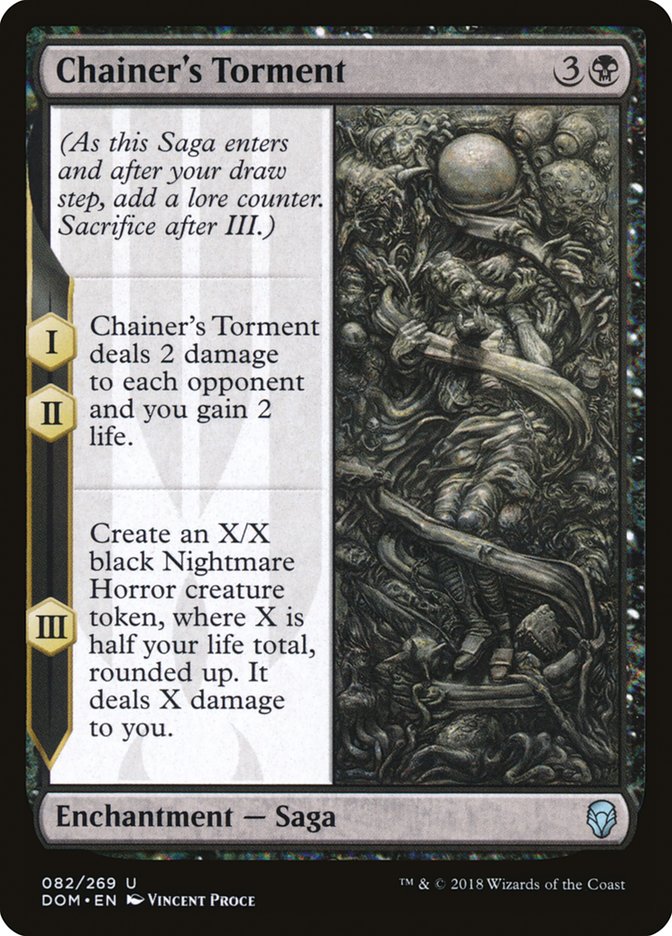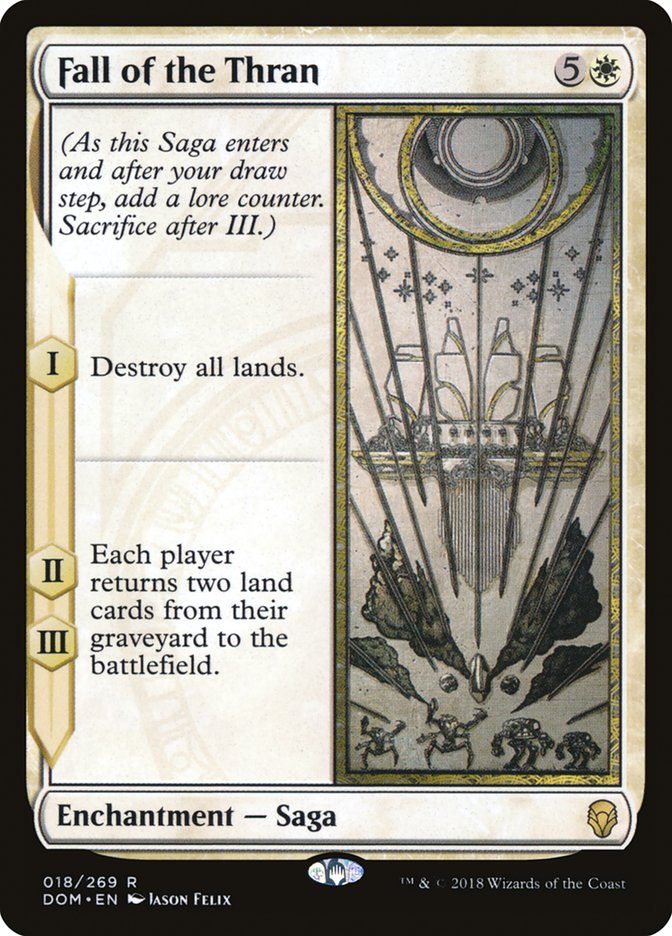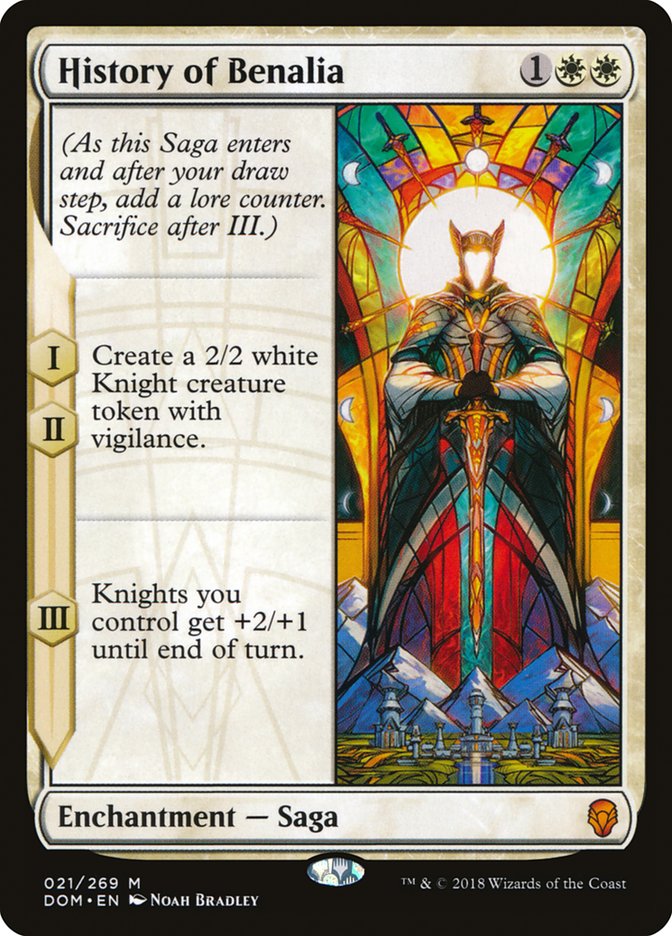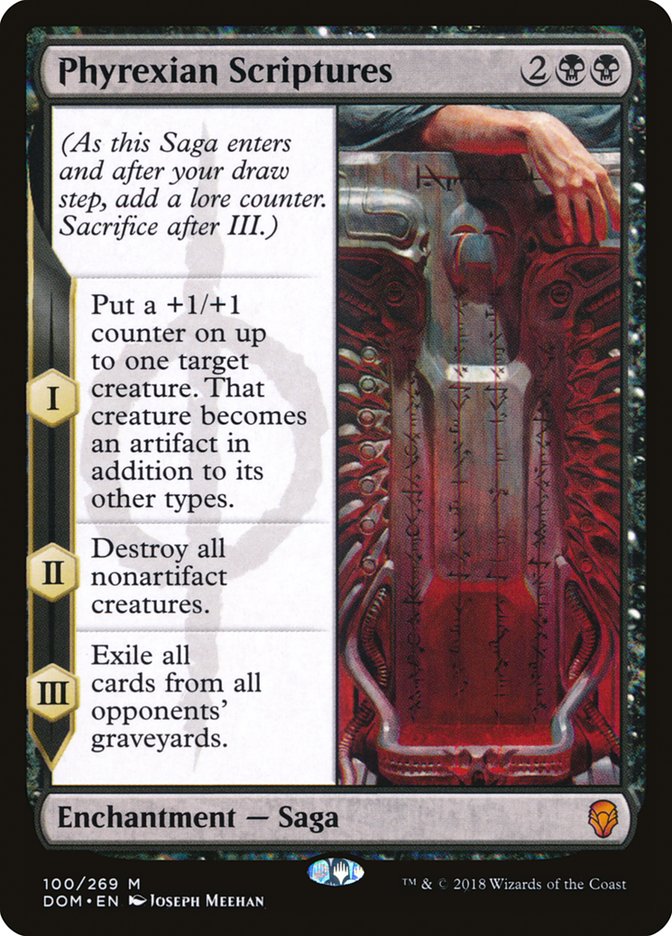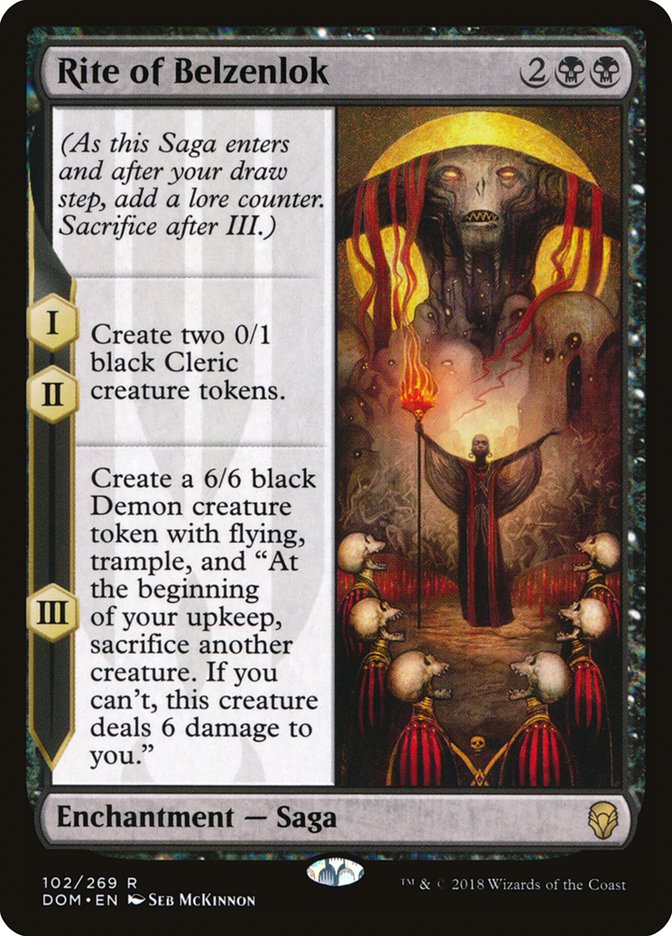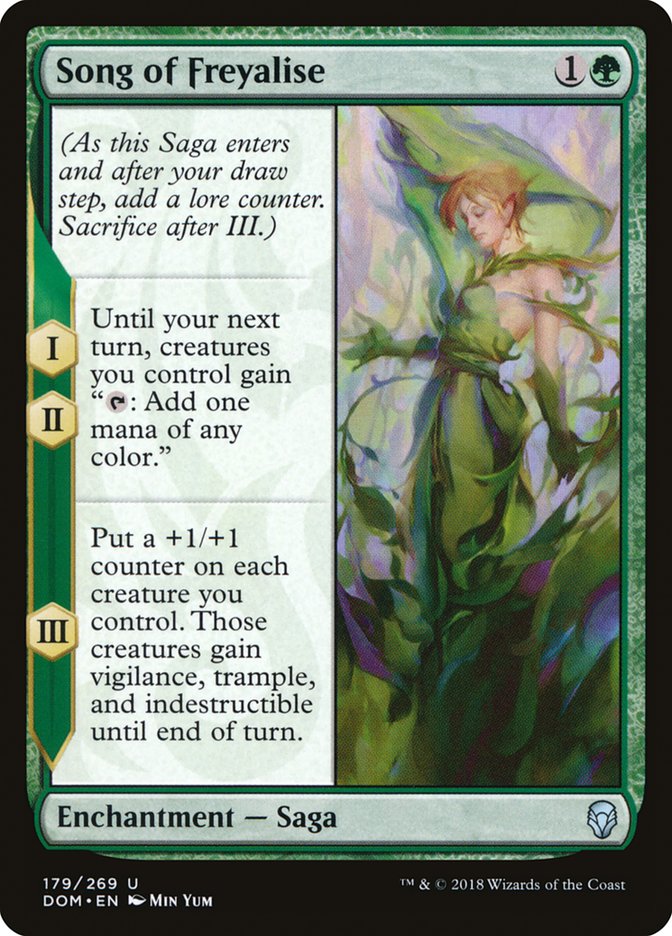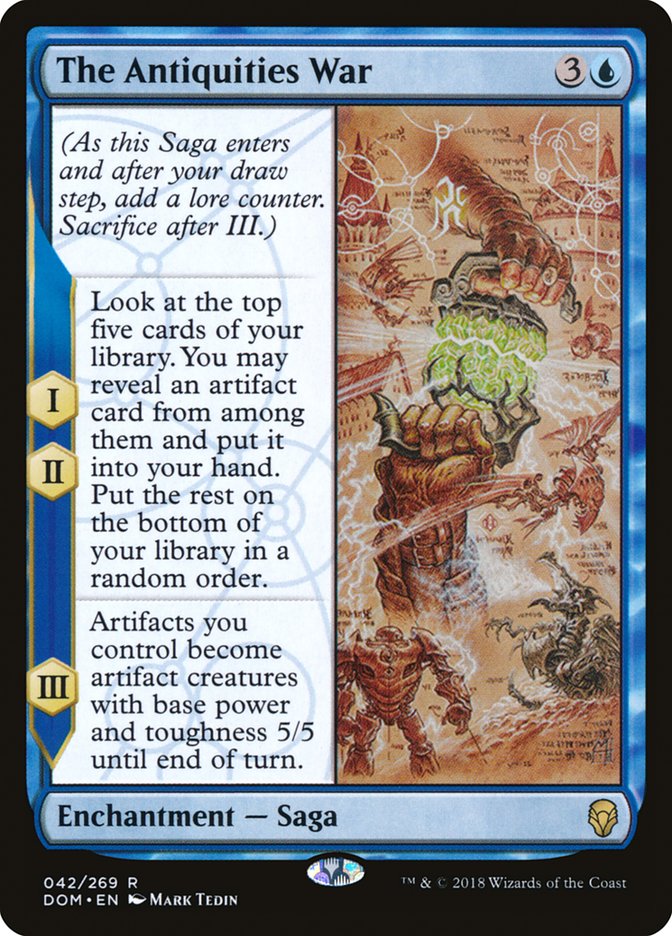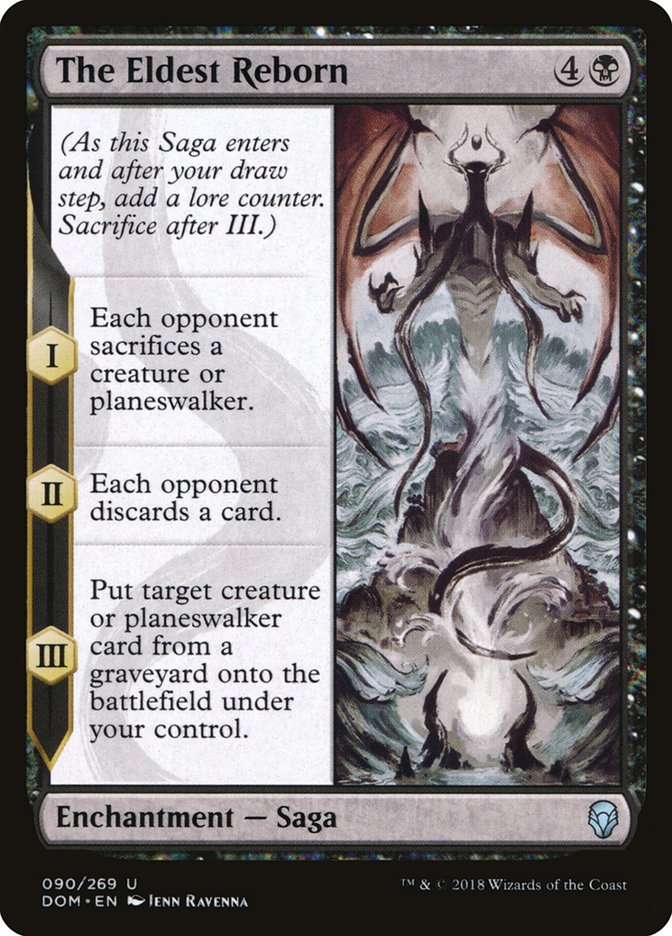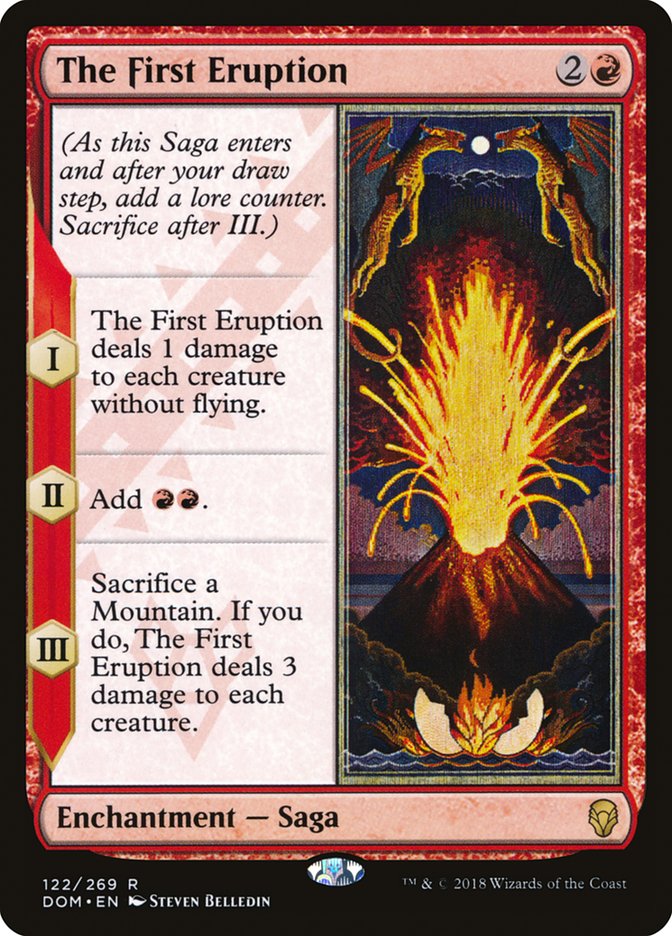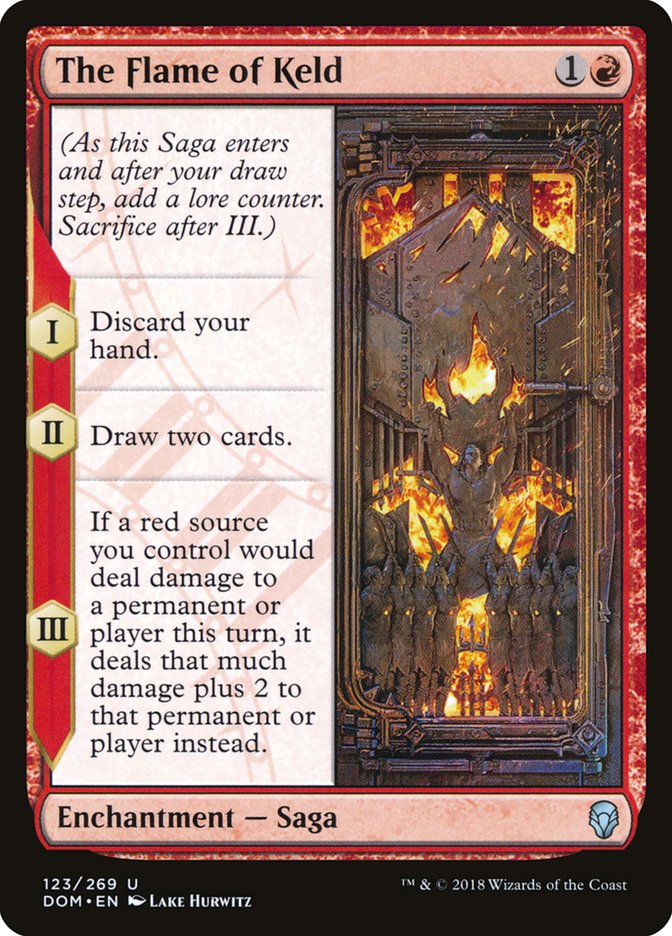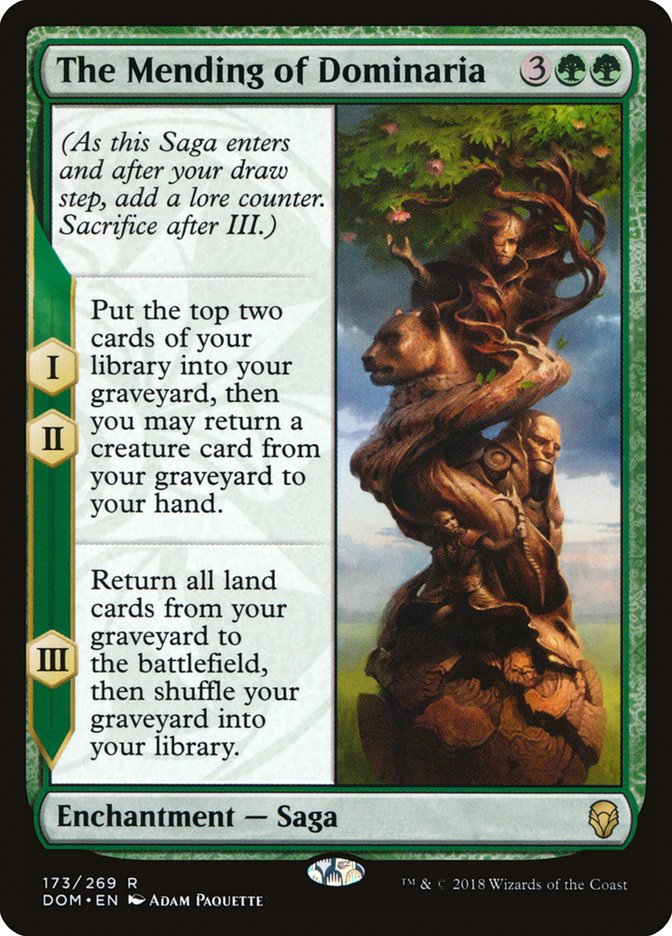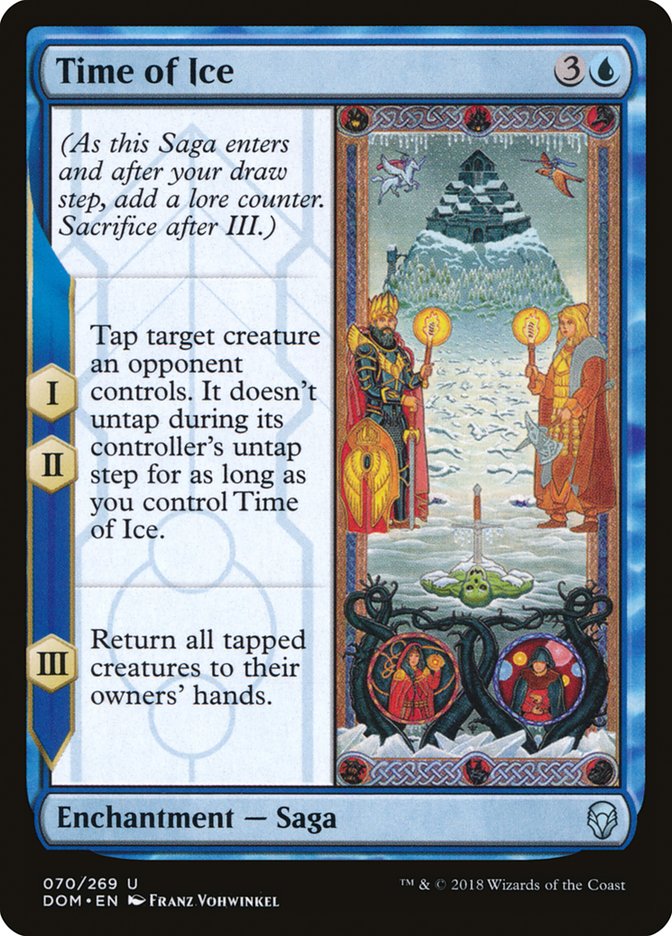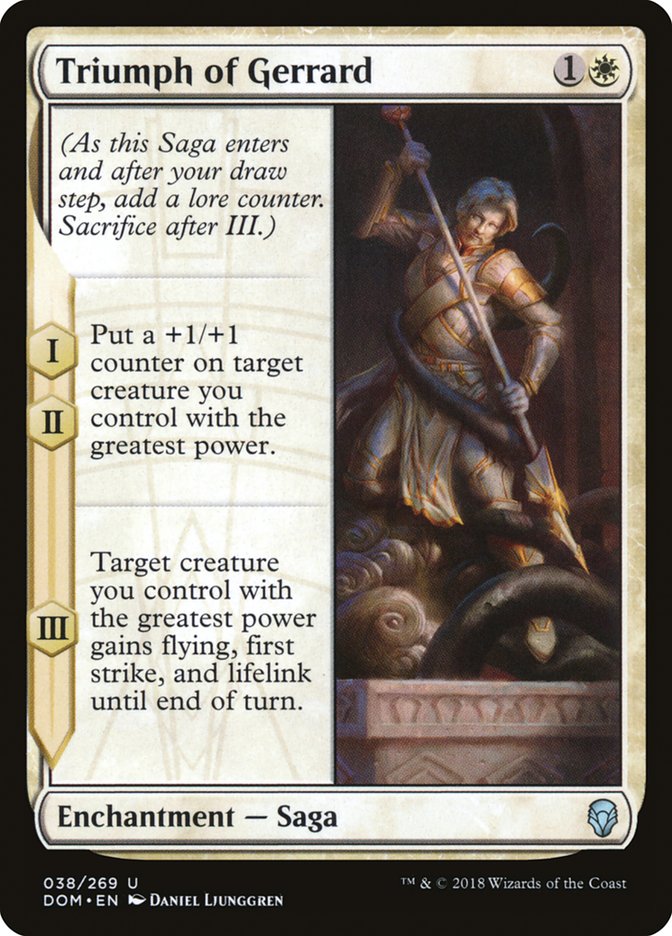I love sagas. Yes, the new cards from Dominaria, but in this case
I’m talking about the sweeping, epic types stories which have become a
major element of our nerdcore culture. In fact, sometime in the late 80’s
or early 90’s, I stopped calling our RPG stories campaigns and called them
sagas. I imagine that many of you running games may have adopted a similar
thinking about your campaign, even if you didn’t adopt the nomenclature. A
saga tells a bigger story than just those of individuals or groups-they’re
about families, organizations, or nations. Dominaria’s Sagas
reflect those large-scale tales and bring them to our Magic tables.
Longtime readers know that I’m also a fan of prog rock and metal. Groups
like Yes, Emerson, Lake, and Palmer, Rush, and Dream Theater bring a
saga-like mentality to much of their music. The question is how do I
combine my love of epic stories (which include RPGs), music, and Magic
together? I’m sure you see this coming: the answer is we go to Dominaria. This will be more of a creative exercise than a
strategic one. I’m going to look at each of the new Sagas and delve into
the kind of tale it suggests-and how we might adapt it into a tabletop RPG
story (doing so without much in-depth knowledge of the lore of Magic’s
early backstories). While most of them would easily fit into a Dungeons and
Dragons/d20 system, if story suggests something different, I’ll mention it.
The Chainer’s Torment Saga involves a central villain who draws life from
neighboring kingdoms in order to create an avatar to go abroad and win its
great war. The events depicted on the card are only the beginning of our
story. Our player characters are scions of the great houses of those
neighboring kingdoms, each of whom has lost an older sibling to the
pestilence which has plagued them for a generation. Coming into their own
not as the leader who was supposed to be, but the leader who is, they must
band together in order to combat the horror which has been unleashed by the
villain, whose own people have flourished while others have suffered. Just
like any story that has a giant thing stalking the world, The Chainer’s
Torment Saga might also be adaptable to the Call of Cthulu RPG as
well as your classic fantasy game. The soundtrack for the Chainer’s Torment
Saga is 100% Led Zeppelin.
The world is a vast wasteland. Loose tribes of people wander the
hard-scrabble landscape in order to survive. Food is scarce. Vegetation is
nearly non-existent. Life is cheap. One of the great threats to “good”
people are the cannibal tribes which have taken famine to its most extreme
steps. The world is dying. And then something miraculous happens. An oasis
blossoms in the hellscape; greenery slowly starts coming back into the
world. We have a number of directions to take the story. Our heroes could
be the investigators of why this is happening or protectors of it (there’s
certainly something to be borrowed from the 2nd Edition AD&D Dark Sun campaign setting-although we’ll probably avoid the dragon
kings). They could be part of what is making it happen; there’s plenty of
room here for either scientific or religious themes. There is no “big bad”
in this saga, which is about the hearts and minds of people and what it
looks like when a world is reborn; the enemy is other cultures and one’s
own greed. There would be a secondary thread here. We’d run a Flashback
setting to the time before the Fall. You know how sometimes even the most
committed folks can’t show up for the game? Everyone would have a secondary
character in the Flashback setting, which we’d adapt so that when someone
can’t come this week, we play the alternate storyline which has some echoes
into the future. Music would be mostly peaceful, sylvan style music (maybe
some Jethro Tull) for the primary setting and the most aggressive grindcore
for the Flashback.
If you want to get your Knight on, the History of Benalia Saga is for you.
Player characters begin as squires and have to work their way through the
ranks to becoming the great heroes of the land. This could also be a
fortress-building saga in which the group (who is related in some fashion,
perhaps) first achieves their titles though the inevitable questing and
then has to settle some outpost in the wilderness. However it goes, the
History of Benalia saga has way more swords than sorcery. The most suited
rules set to this one would be the
Pendragon
system (originally from Chaosium and eventually White Wolf). Music for this
saga would be
Rick Wakeman’s
Myths and Legends of King Arthur and the Knights of the Round Table
on constant loop.
In what will eventually become a horror scenario (although the PCs don’t
know it for the first major part of the game) is that they are part
person/part machine, the results of experimentation on prolonging life
and/or achieving immortality. I’d avoid the “machinations of an evil
wizard” trope here; Phyrexian Scriptures is best served as a space/science
game set in the near or not too distant future. The PCs are part of the
defense force of an outpost planet who must defend the science complex from
hostile (but not overwhelmingly so) indigenous life forms. One of themes to
explore is the impact of colonization of new worlds on the people already
living there. The GM must manage all of this carefully. They must make high
science-based healing a part of the game. The tide turns when the
characters realize that their bodies aren’t being healed, but their parts
being replaced. Whether they revel or rebel us up to the tastes of the
group. Music is a selection of Hans Zimmer film soundtracks.
It would be tempting to make this into a version similar to Chainer’s
Torment, which is what I’d do, but with a twist-in Rite of Belzenlok, the
PCs are on the side of the villain. They’re essentially “good,” (or maybe
just patriotic), but their boss’s creation has gotten out of hand. They
must deal with the blowback. It would be easy for a group who likes to play
evil characters to do this one, but my experience is evil PC campaigns are
not sustainable into sagas. What we’d have to do here is make the PCs the
inheritors of the mess. The “if you can’t” part of the card becomes their
boss getting eaten, and they have to figure out what to do next, especially
since none of them wants to be a despot. If you’re not playing goth music
here, you’re probably doing it wrong.
All is right in Freyalise’s realm, a place of life and growth sequestered
from the darkness and destruction without. If you’re Elf-happy, even if you
don’t necessarily play out-of-the-book Elves, this is the setting for you.
Each of the early chapters of this saga involve the characters growing in
power and responsibility (effectively, becoming the “larger creatures” that
you can summon with the mana). The third chapter comes when the outside
world encroaches and they have to go to war to defend their homeland
(getting all tramply, vigilant, and indestructible). The turning point
comes when some of their comrades (or maybe they themselves), awash with
the headiness of power, don’t stop at defending their homeland, but decide
to become imperialists. The war to defends the borders becomes the battle
to protect the spirit of the land. Enya for early chapter music, giving way
to more Hans Zimmer for the battle stuff.
I’m embarrassed to admit I don’t know too many of the details of the lore
behind the fight between Urza and Mishra, but this is where it gets played
out. Common themes of the dangers of excessive scientific growth without
the accompanying social progression apply. I would have the PCs be on the
losing side (so Mishra’s), perhaps even knowing that they’re fighting a war
that they can’t win in the long run. In carefully designed scenarios, the
PCs continue to have victories-but somehow continue to lose ground in the
war. The culmination of this saga is not whether or not they can win, but
how they face defeat, a much more compelling tale to me. There’s an obvious
next level here: the end of this saga is the pre-history in the Fall of
Thran. Music is anything electronica, from early Kraftwerk to the daftest
Daft Punk.
In a bit of borrowing from my own setting and a somewhat common story from
across the fantasy genre, the PCs become the heroes of the elder days
reborn into the world to face its darkest hour. The distinct movements of
this saga become the PC’s efforts to “qualify” to become the heroes reborn.
Unlike in other games or stories (such as Michael Moorcock’s Elric of
Melnibone’ saga), the knowledge of the rebirth isn’t a secret; the
mechanism might be known to only a few, but goal is well known. This might
be one of the few situations in which I was willing to have there be PvP
action. Early scenarios would involve intra-party competition to be chosen.
Then the winning character would be set aside, and the players would play
new characters until a number equal to the group members is picked. If one
player “wins” more than once, they obviously get to play the character of
their choice, with the selection passing down-but that doesn’t mean much,
since the original personality gets overwritten anyway. We’d then do a
cooperative design of the heroes they’re being born into. The theme song of
this saga is
Dream Theater’s cover of Deep Purple’s Perfect Strangers
. Lots of Dio, Deep Purple, and Black Sabbath make up the rest of the
soundtrack.
Set in a volcano-rich landscape, characters of The First Eruption saga must
deal with life in which fire may rain from the sky any day. They survive by
building their homes in hillsides and beneath the ground, which brings its
own difficulties in shifting landscape. In this high-action saga, the
dangers are plenty and prevalent, from the invading cultures that wish to
take over “safer” locations to beings of pure lava which escape from below.
In what would be the most goal-oriented saga, the finale would involve (or
not; again, what the characters go through is a better story than if they
actually succeed or not) acquisition of the artifact which will bring some
peace and stability to the world: The Winter Orb.
The polar opposite (perhaps in more than one sense) to The First Eruption,
the Flame of Keld is about the final flame. In a wind-swept and Ice-Age
like world, priests of the different gods have maintained some kind of
balance over the centuries/millenia. The Flame of Keld is about the
ascendency of the god of fire. That the fire god will rise is inevitable.
The battle here is among the various factions. PCs are members of one of
those factions, which fight others for primacy and control of the Flame of
Keld-which, of course, in the end isn’t an actual fire, but a person.
Control of the Flame leads to a battle to change the climate of the world
into something less snowy. Music is a series of Gregorian chants
occasionally interrupted by Orff’s
Carmina Burana
.
Read
Guy Gavriel Kay’s The Summer Tree
. Discard the modern world bits (I’m really not a fan of this overdone
trope in the genre, but to each their own). Let the poetry of Kay’s writing
guide the creation of the saga setting which demands that people
occasionally sacrifice themselves to replenish the spirit of the land.
There is significant divide within the society if this is entirely
necessary. PCs then exist on one side of the debate or the other-rebels
against what the find a murderous society or defenders of the idea of grave
responsibility. I’m more a fan of the latter since the former is once again
a story retold. Not all is well, of course, in the society. There is the
corruption of power among the druid/priests who manage the sacrifices,
which are a matter of pride and competition, perhaps even enlightenment.
Our heroes must set right what is falling by the wayside so that the spirit
of the Summer Tree is not corrupted, but eternal. Music is a selection of
pieces by Turlough O’Carolan on the hammered dulcimer.
The Mirari Conjecture Saga is about power, power, and more power in the
light of a lack of power. It is the RPG version of
Ayn Rand’s novella Anthem
, as suggested by
Rush on their album 2112
, with elements of Planet of the Apes thrown in. The world is
relatively simple, except of course, it’s not. The PCs are members of a
subjugated minority-whether that’s based on gender, race, class, or
whatever other factor, is left for the group to collectively decide. In a
version of the “you start the game locked in a prison cell” trope, the
group are part of the servant class to the powerful priests who run the
society. They uncover the dark secret that the priests engineered the
devolution of the society (socially and technologically) in order to
consolidate their nefarious power. The “treasure” the group earns/finds is
technology, with which they might overcome the arcane power of the
priesthood. The technology level is once again up to the group-to they want
to rediscover electricity or the long-lost power of replication or
teleportation. Whatever it is, they must successfully answer the question
“What is the Mirari Conjecture?” Contemporary urban music somehow tailored
to the tech level is what we’ll use here.
On the list of things which I’m not a fan of, time travel is near the top.
I think it tends to lead to weak writing. If we could use time travel in a
fashion unlike what it’s currently used, I might be on board. Such is the
case with the Time of Ice Saga. The rich denizens of a desert world control
society via their access to water (obviously). In this saga, their supply
is via portals through time-when the world was icy instead of hot. Travel
through these portals is not without its costs. Each time one passes
through, some negative side occurs; I’m thinking some cool d100 chart.
RPGers love charts. Once again in contrast to what tale would commonly be
told-that of the rebel-the Time of Ice Saga is about the brave heroes who
face the dangers of the prehistoric world (like snow dinosaurs!) so that
the modern one might live. The culmination of the saga would be to create a
situation in which no one had to travel through the portals-unlocking the
secrets of The Time of Ice. In the modern world, the music is that creepy
music box stuff they used on The Twilight Zone. Through the portal, West
Coast rap.
The player characters in the Triumph of Gerard Saga are the descendants of
the great hero-whether that is sons and daughters, grandchildren, or
several generations removed. Truth is, Gerard was a badass and none of his
line have even come close to measuring up. Our heroes are the ones who
will. We have a great deal in latitude in sculpting what exactly our Gerard
(as opposed to the Weatherlight one) did to have himself immortalized; the
art on the card easily translates into a tapestry or a statue. What makes
some level of resonant sense is that the offspring of whatever Gerard
overcame, whether that was a person or a creature, has plagued his hero
family ever since and they’ve never gotten the upper hand. The PCs must
then tread the paths their great forebear did while making their own names,
making themselves into the statues of tomorrow.
More than any other format, Commander lets us think with the creative side
of our brains. We bring great characters to the table with us and can
imagine the crackling hearth and the stories told around it about them. The
next time you’re at a table with your favorite hero, think about what great
feats their saga might include.
This week’s Deck Without Comment is one of those I’ll bring with me to
#SCGCon next month,
Kresh Into the Red Zone
.
Creatures (34)
- 1 Solemn Simulacrum
- 1 Kokusho, the Evening Star
- 1 Withered Wretch
- 1 Eternal Witness
- 1 Yavimaya Elder
- 1 Bloodshot Cyclops
- 1 Stalking Vengeance
- 1 Greater Gargadon
- 1 Big Game Hunter
- 1 Hamletback Goliath
- 1 Seedguide Ash
- 1 Farhaven Elf
- 1 Woodfall Primus
- 1 Kresh the Bloodbraided
- 1 Lord of Extinction
- 1 Anathemancer
- 1 Acidic Slime
- 1 Butcher of Malakir
- 1 Pelakka Wurm
- 1 Urabrask the Hidden
- 1 Scavenging Ooze
- 1 Devouring Swarm
- 1 Disciple of Griselbrand
- 1 Mikaeus, the Unhallowed
- 1 Flayer of the Hatebound
- 1 Malignus
- 1 Disciple of Bolas
- 1 Nighthowler
- 1 Xenagos, God of Revels
- 1 Kozilek, the Great Distortion
- 1 Regal Behemoth
- 1 Combustible Gearhulk
- 1 Heart-Piercer Manticore
- 1 Etali, Primal Storm
Planeswalkers (1)
Lands (37)
- 1 Strip Mine
- 10 Forest
- 1 Reflecting Pool
- 1 Volrath's Stronghold
- 4 Swamp
- 1 Mountain
- 1 Taiga
- 1 Bayou
- 1 Badlands
- 1 Temple of the False God
- 1 Phyrexian Tower
- 1 Overgrown Tomb
- 1 Stomping Ground
- 1 Blood Crypt
- 1 Rakdos Carnarium
- 1 Graven Cairns
- 1 Twilight Mire
- 1 Savage Lands
- 1 Exotic Orchard
- 1 Reliquary Tower
- 1 Dragonskull Summit
- 1 Bojuka Bog
- 1 Command Tower
- 1 Kessig Wolf Run
- 1 Grim Backwoods
Spells (28)
- 1 Living Death
- 1 Sol Ring
- 1 Goblin Bombardment
- 1 Grave Pact
- 1 Kodama's Reach
- 1 Tangle
- 1 Skullclamp
- 1 Grab the Reins
- 1 Fling
- 1 Survival of the Fittest
- 1 Greater Good
- 1 Skyshroud Claim
- 1 Pernicious Deed
- 1 Cauldron Dance
- 1 Tormod's Crypt
- 1 Makeshift Mannequin
- 1 Lurking Predators
- 1 Momentous Fall
- 1 Cultivate
- 1 Essence Harvest
- 1 Flesh
- 1 Chandra's Ignition
- 1 Vampiric Rites
- 1 Deadly Tempest
- 1 Ever After
- 1 Verdant Rebirth
- 1 Dead Man's Chest
- 1 Phyrexian Scriptures

Check out our comprehensive Deck List Database for lists of all my decks:
SIGNATURE DECKS
Purple Hippos and Maro Sorcerers
;
Kresh Into the Red Zone
;
Halloween with Karador
;
Dreaming of Intet
;
You Did This to Yourself
.
THE CHROMATIC PROJECT
Mono-Color
Heliod, God of Enchantments
;
Thassa, God of Merfolk
;
Erebos and the Halls Of The Dead
;
Forge of Purphoros
;
Nylea of the Woodland Realm
;
Karn
Evil No. 9.
Guilds
Lavinia Blinks
;
Obzedat, Ghost Killer
;
Aurelia Goes to War
;
Trostani and Her Angels
;
Lazav, Shapeshifting Mastermind
;
Zegana and a Dice Bag
;
Rakdos Reimagined
;
Glissa, Glissa
;
Ruric Thar and His Beastly Fight Club
;
Gisa and Geralf Together Forever
.
Shards and Wedges
Adun’s Toolbox
;
Angry, Angry Dinos
;
Animar’s Swarm
;
Borrowing Stuff at Cutlass Point
;
Ikra and Kydele
;
Karrthus, Who Rains Fire From The Sky
;
Demons of Kaalia
;
Merieke’s Esper Dragons
;
Nath of the Value Leaf
;
Rith’s Tokens
;
The Mill-Meoplasm
;
The Altar of Thraximundar
;
The Threat of Yasova
;
Zombies of Tresserhorn
.
Four Color
Yidris: Money for Nothing, Cards for Free
;
Saskia Unyielding
;
Breya Reshaped
.
Five-Color
Partners
Tana and Kydele
;
Kynaios and Tiro
;
Ikra and Kydele
.
THE DO-OVER PROJECT
Adun Oakenshield Do-Over
;
Animar Do-Over
;
Glissa Do-Over
;
Karador Do-Over
;
Karador Version 3
;
Karrthus Do-Over
;
Kresh Do-Over
;
Steam-Powered Merieke
Do-Over;
Lord of Tresserhorn Do-Over
;
Mimeoplasm Do-Over
;
Phelddagrif Do-Over
;
Rith Do-Over
;
Ruhan Do-Over
.
If you’d like to follow the adventures of my Monday Night RPG group (in a
campaign that’s been alive since 1987) which is just beginning the saga The Lost Cities of Nevinor, ask for an invitation to the Facebook
group “Sheldon Menery’s
Monday Night Gamers.”


